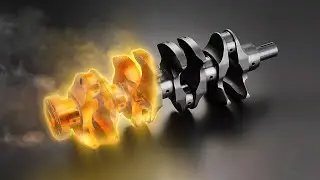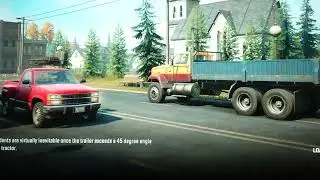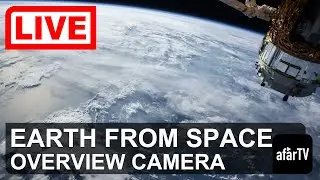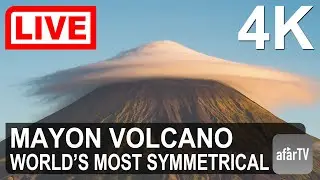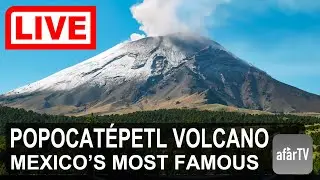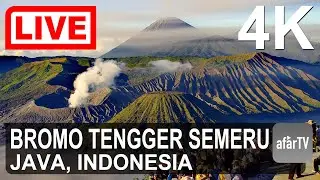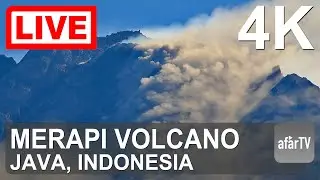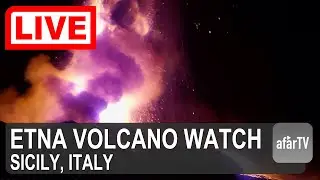🔴 Live Now: New Kilauea Volcano Eruption in Hawaii (Fullscreen)
на канале: afarTV
USGS Report for Feb 11, 2025: Episode 9 of the ongoing Halemaʻumaʻu eruption began this morning, February 11 at 10:16 a.m. HST with lava fountains producing a lava flow on Halemaʻumaʻu crater floor.
Episode 9 was preceded by small, sporadic spatter fountains that began early yesterday morning and increased in intensity overnight. Fountains from the north vent are estimated to be roughly 330 feet (100 meters) high at 10:45 a.m. and covering about a quarter of the Halemaʻumaʻu crater floor. Slow effusion of lava at the south vent began at approximately 10:50 a.m.
Inflationary tilt at the summit recovered about 9 microradians since the previous eruptive episode. Seismic tremor began increasing and tilt at UWD switched from inflation to deflation at about 10:25 a.m. HST.
No changes have been detected in the East Rift Zone or Southwest Rift Zone. HVO continues to closely monitor Kīlauea and will issue an eruption update tomorrow morning unless there are significant changes before then.
Kīlauea Volcano Alert Level/Aviation Color Code remain at WATCH/ORANGE. All current and recent activity is within Hawaiʻi Volcanoes National Park.
Hazards:
This episodic eruption is occurring within a closed area of Hawai'i Volcanoes National Park. High levels of volcanic gas—primarily water vapor (H2O), carbon dioxide (CO2), and sulfur dioxide (SO2)—are the primary hazard of concern, as this hazard can have far-reaching effects downwind. As SO2 is continuously released from the summit during an eruption, it will react in the atmosphere to create the visible haze known as vog (volcanic smog) downwind of Kīlauea. Vog information can be found at https://vog.ivhhn.org/.
Additional hazards include Pele's hair and other volcanic fragments from lava fountains that can fall on the ground downwind of the eruptive vent(s). Pele's hair are strands of volcanic glass produced by lava fountaining activity. Strong winds may waft these light particles to greater distances downwind. Pele's hair can sometimes cluster and tangle together on the ground, giving it the appearance of a tumbleweed. The extent of Pele's hair is dependent on lava fountaining activity and current wind conditions. Residents and visitors should minimize exposure to these volcanic particles, which can cause skin and eye irritation. More information about how Pele's hair is formed is available here: https://www.usgs.gov/observatories/hv.... A Frequently Asked Questions document developed for the 2022 Mauna Loa eruption includes information about potential health effects of Pele's hair and is available here: https://vog.ivhhn.org/sites/default/f...
Hawaiian lava flows generally advance slowly downslope, and during this eruption flows have been confined to Halemaʻumaʻu and the southwest side of Kaluapele, Kīlauea's summit caldera.
Other significant hazards also remain around Kīlauea caldera from Halemaʻumaʻu wall instability, ground cracking, and rockfalls that can be enhanced by earthquakes within the area closed to the public. This underscores the extremely hazardous nature of Kīlauea's caldera rim surrounding Halemaʻumaʻu, an area that has been closed to the public since late 2007.
----
Sources
A special thanks to all the hardworking scientists, government officials, companies and private citizens for the work that they do which makes this live stream possible:
Windy.com - so2 and wind data and maps
Google Earth - maps
USGS - cameras, earthquake data, and activity reports
Smithsonian Institute - Volcanic activity
RaspberryShake.com - earthquake activity
VolcanoDiscovery.com - Research
----
You can help monitor earthquakes!
Dive into the fascinating world of seismology and join a global network of hobbyists using Raspberry Shake’s powerful earthquake sensors. Get 10% off your own monitor by visiting this link:
https://shop.raspberryshake.org/?ref=...
----
Join the Community
🌐 Chat Live: Engage with fellow volcano enthusiasts and share your thoughts in our live chat.
📸 Screenshots: Capture and share your favorite moments from the stream.
🔔 Subscribe: Don’t miss out on any action – subscribe and hit the bell icon for notifications.
☕ Become a Member: Support our channel and get access to perks!:
/ @afartv
----
Support the Stream
👍 Like: If you enjoy the stream, please give it a thumbs up.
💬 Comment: Let us know what you think or ask any questions you have about Fuego Volcano.
🔗 Share: Spread the excitement by sharing this live stream with friends and family.
☕ Join this channel to get access to perks:
/ @afartv
Sound is not live and is recorded from a previous eruption.
Main Source: USGS

